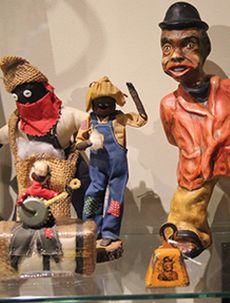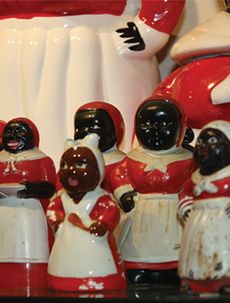Jim Crow Museum of Racist Memorabilia facts for kids
 |
|
| Lua error in Module:Location_map at line 420: attempt to index field 'wikibase' (a nil value). | |
| Established | 1996 |
|---|---|
| Location | Big Rapids, Michigan |
| Type | History museum |
| Collection size | 10,000 |
| Owner | Ferris State University |
The Jim Crow Museum of Racist Memorabilia is a special place at Ferris State University in Big Rapids, Michigan. It shows many everyday items that tell the story of how African Americans were unfairly shown in American culture. The museum's main goal is to use these difficult objects to teach people about kindness and fairness for everyone.
The museum has more than 10,000 items. Most of these were made between the 1870s and the 1960s. Some newer items are also on display. The museum gets its name from "Jim Crow." This was a made-up character from old song-and-dance shows. By 1838, "Jim Crow" became a mean way to refer to Black individuals. Later, laws that separated people by race were called the Jim Crow laws.
The museum helps us understand how unfair ideas and images against Black people were common in American culture. It also shows items related to modern forms of racism. You can also learn about the great achievements of African Americans and the Civil Rights Movement.
Contents
How the Museum Started
David Pilgrim, a former sociology professor, started collecting racist items in the 1970s. He found them at flea markets across America. By 1996, he had gathered over 2,000 pieces. Pilgrim decided to give his collection to Ferris State University. He felt it needed a proper home.
For 15 years, the collection was in a small room. It was used to teach university classes. In 2012, the Jim Crow Museum opened to the public. It moved into a larger, new space. This new home is in the lower level of Ferris State University's FLITE Building.
What You Can See: The Collection
The Jim Crow Museum holds over 10,000 items. Most of these objects were made between the 1870s and the 1960s. A large part of the museum's collection is anti-Black memorabilia. These include items like mammy candles and lawn jockeys.
The museum also displays items related to Jim Crow laws. These are things like books, signs, tickets, and photos. They were used to promote racial separation.
The Museum's Important Goal
The Jim Crow Museum at Ferris State University wants to lead the way in social action. It aims to encourage discussions about race and how people of different races get along. Many students today do not fully understand the terrible impact of Jim Crow laws and customs. They might not know about things like literacy tests or poll taxes. These were unfair rules that made it hard for Black people to vote or live freely.
The Jim Crow Museum gives students a chance to learn about this time in American history. Most of the items in the museum were made to make African Americans feel small and unimportant. However, the museum staff believes these objects can be used in a positive way. They can help start smart talks about race and racism.
Woodbridge N. Ferris founded Ferris Institute. This is now Ferris State University. He challenged everyone to "make the world a better place." The Jim Crow Museum is one way the university tries to improve the world. Its mission is to "use objects of intolerance to teach tolerance and promote social justice."
What's on Display: Exhibitions
The Jim Crow Museum is open to everyone. It is free to visit. The museum has six main exhibit areas:
- Who and What was Jim Crow
- Jim Crow Violence
- Jim Crow and Anti-Black Imagery
- Achieving Despite Resistance
- The Battle Continues (about modern forms of racism)
- A New Wave of Egalitarianism (showing positive images of African Americans)
The museum also has a detailed timeline of the African American experience in the United States. This timeline is split into six parts: Africa Before Slavery, Slavery in America, Reconstruction, Jim Crow, Civil Rights, and Post Civil Rights.




